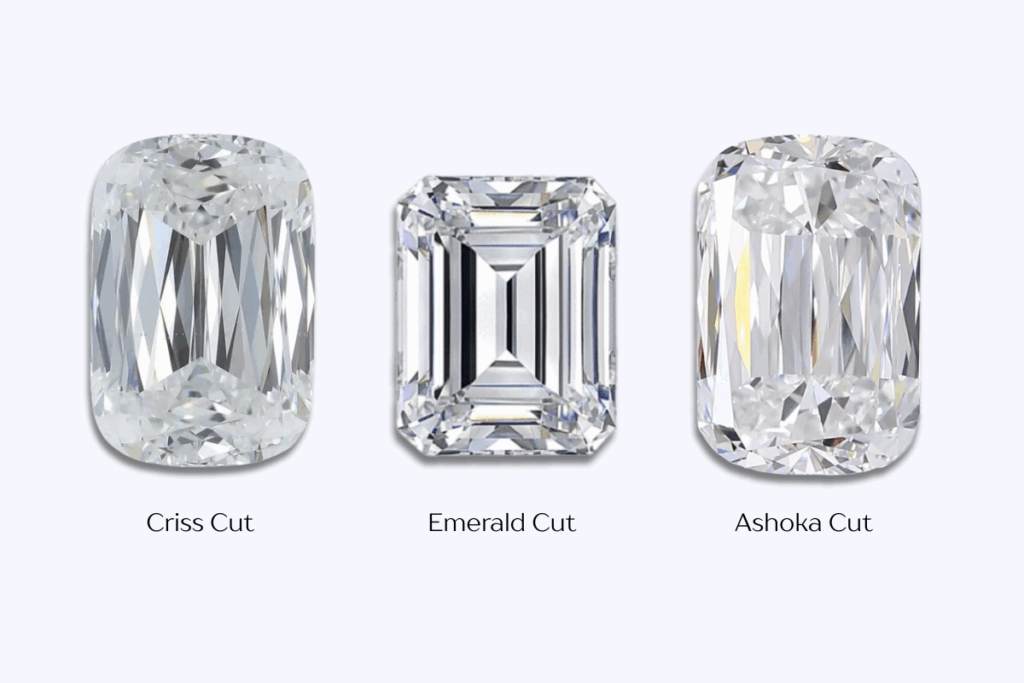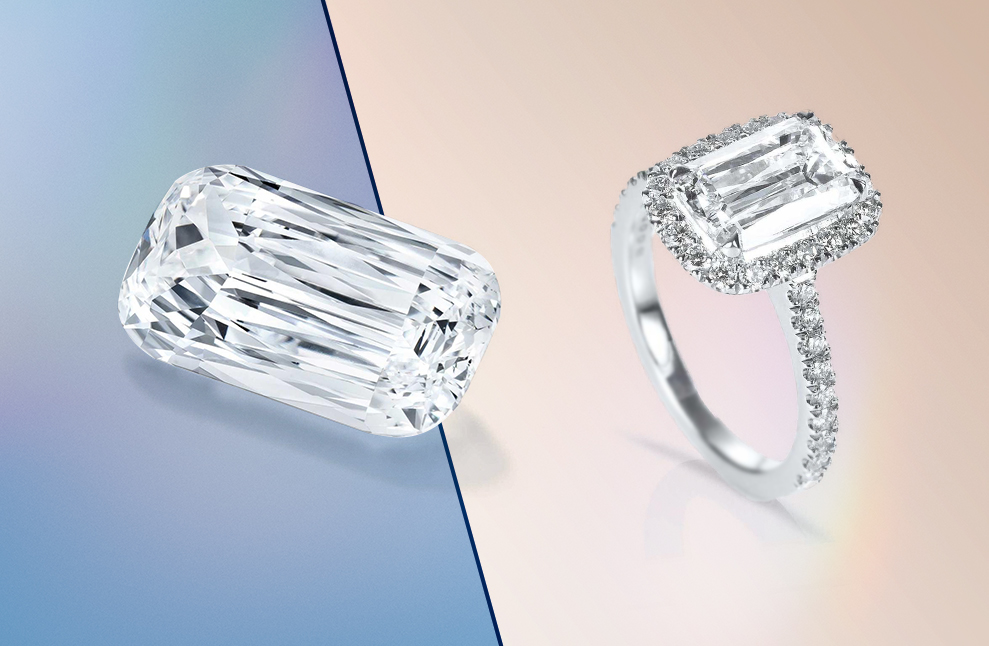What Makes an Ashoka Cut Diamonds Unique? Styles, Trends, and Buying Tips
With over 10 years of experience in fine jewelry craftsmanship and lab-grown diamond innovation, we’ve personally worked with rare cuts like the Ashoka in both natural and lab-created forms. Our team at Finegrown has helped collectors, retailers, and couples worldwide source and customize these extraordinary stones. In this guide, we’ll share insider knowledge, from the Ashoka cut’s royal history to modern buying tips, so you can make an informed, confident purchase.
What is an Ashoka Cut Diamond?

An Ashoka cut diamond is a patented diamond shape by the Goldberg family, featuring 62 facets, an elongated cushion outline, and rounded corners. It delivers exceptional brilliance but requires large, flawless rough diamonds, making it rare and expensive.
What truly sets the Ashoka cut apart is its requirement for a large, at least 3-carat size, flawless rough diamond in the crafting of the whole cutting process that meets exacting standards. Only a small percentage of rough diamonds meet the criteria for transforming into this distinctive cut, making it a luxurious and sought-after option. And that’s why the rarity of the Ashoka cut in natural diamonds contributes to its high cost.
How the Ashoka Cut Diamond Was Created and Named
The Ashoka cut was introduced by the William Goldberg Diamond Corporation, a renowned name in the diamond industry.
Named after the legendary Indian emperor Ashoka, who ruled during the Maurya dynasty, the diamond cut draws inspiration from the emperor’s legacy of grandeur and magnificence. The Ashoka cut was specifically designed to pay homage to the emperor’s legendary 41.37-carat diamond, which is believed to have been one of the largest diamonds ever discovered.
Where Did the Ashoka Diamond Come From?
The legendary Ashoka diamond, a notable example of legendary gems, originated from the famous Golconda mines in India. It was later brought to prominence by William Goldberg, a renowned diamantaire who transformed rough stones and trademarked the unique Ashoka cut in 2000. This exquisite cut has since captivated diamond enthusiasts with its exceptional craftsmanship and intriguing history.
Ashoka Cut Diamonds Today
While the Ashoka cut was created in the late 1970s, it has seen a resurgence in popularity in recent years as consumers seek out unique and distinctive diamond shapes. Several major diamond companies now offer Ashoka cut diamonds in their collections. The Ashoka cut is a patented design owned by William Goldberg Diamond Corporation, based in New York. Only diamonds cut and certified by them can be officially called “Ashoka” diamonds. This exclusive branding adds to their rarity and prestige.
In 2010, the Ashoka diamond cut stepped into the global spotlight when Jim Toth proposed to actress Reese Witherspoon, a notable Mexican actress, with a stunning 4-carat custom Ashoka cut engagement ring. This unique, 62-facet diamond shape was largely unknown to the general public at the time, as Ashoka cuts are extremely rare and exclusive.
Difference Between Ashoka vs Emerald Cut And Criss-Cut Diamond

The difference between an Ashoka cut and an emerald cut is simple: you can tell the difference by just looking at it. But when it comes to a criss cut diamond, it is a very good and go-to option if you don’t want to spend a much but also want the same look, they are very similar looking diamonds in appearance, size, sparkle, and all. Here is the detailed difference table of each;
| Feature | Ashoka Cut | Emerald Cut | Emerald Criss Cut |
|---|---|---|---|
| Overall Look | Softly rectangular with rounded corners and brilliant sparkle | Sleek rectangle with sharp corners and clean step facets | Rectangular with unique crisscross facets for extra light play |
| Sparkle Level | High, 62 facets for maximum fire and brilliance | Low to medium, more subtle flashes than sparkle | High, similar brilliance to Ashoka, but with a slightly different pattern |
| Shape Feel | Romantic and vintage-inspired | Elegant and architectural | Balanced, combines Ashoka’s romance with Emerald’s structure |
| Rarity | Very rare, limited cutters make this | Common, widely available in most sizes | Rare, but easier to source than Ashoka |
| Best For | Those who want something unique and conversation-worthy | Minimalists who love clean lines and sophistication | Buyers who want Ashoka’s look with more availability and similar brilliance |
| Price Range | Higher rarity adds value | More affordable compared to Ashoka | Mid-to-high, usually less than Ashoka but more than standard emerald cut |
Most Popular Ashoka Cut Diamond Jewelry Styles and Trends
The Ashoka cut diamond is becoming increasingly popular in various jewelry styles, reflecting current trends in the market. This unique cut, often compared to a modified cushion cut, effortlessly combines classic elegance with its elongated shape and contemporary flair. Many jewelry designers are embracing the Ashoka shape, integrating it into a range of settings, from vintage-inspired pieces to modern minimalist designs.
Ashoka cut Diamond Engagement Rings are the Most Sought-After
Today, Ashoka diamonds are frequently seen in engagement rings and statement pieces that highlight their brilliance and rarity, making them one of the most coveted gems in the market. Many couples are opting for Ashoka engagement rings due to their unique shape and the captivating sparkle they provide. The cut’s versatility allows it to pair beautifully with different metals and styles, making it a perfect choice for any jewelry lover looking to make a statement.
Where to Buy Ashoka Cut Diamonds Jewelry?
Finding an authentic Ashoka cut diamond can be a rewarding experience, especially for those who value unique and luxurious jewelry, including an Ashoka engagement ring. While these diamonds are relatively rare, a few reputable retailers in New York and beyond cater to anonymous buyers looking for this exclusive cut. It’s essential to seek out certified jewelers who specialize in Ashoka cuts to ensure you are purchasing a genuine product. Many of these retailers maintain a selection of Ashoka engagement rings and other jewelry, showcasing the unique beauty and craftsmanship of this diamond cut.
To Buy Authentic Diamonds: Notable Jewelers Offering Ashoka Cut Diamonds
When it comes to purchasing Ashoka diamonds, several renowned jewelers are at the forefront of offering these exclusive pieces:
- William Goldberg: As the pioneer of the Ashoka cut, William Goldberg is synonymous with luxury and craftsmanship. They offer a beautiful selection of Ashoka engagement rings, including iconic designs like the Reese Ring, capturing the essence of elegance and exclusivity on William Goldberg Way.
- Kwiat: Known for its commitment to quality, Kwiat is the only other U.S. retailer authorized to sell Ashoka cut diamonds. Their collection features a dazzling array of engagement rings that highlight the diamond’s unique brilliance and beauty.
- Boodles: Based in the United Kingdom, Boodles is the sole retailer in the U.K. to offer Ashoka cut diamonds. They provide a range of exquisite jewelry pieces, from earrings to necklaces, ensuring that every buyer can find something special that showcases this remarkable cut.
Exploring these jewelers can significantly enhance your shopping experience, helping you find the perfect Ashoka diamond that meets your tastes and preferences.
If your Budget is Low
Thanks to today’s advanced diamond-cutting technology, you can get a custom Ashoka cut in a lab grown diamond. The key is finding a skilled vendor who specializes in precision cutting and has experience with unique custom shapes. These experts can create an Ashoka cut to your exact size, proportion, and sparkle preferences, making it a perfect choice for anyone who wants a rare look with the benefits of lab-grown diamonds. This also gives you more flexibility in budget, design, and sustainability without compromising beauty.
Other Affordable Options:
- Crisscut Emerald Diamond
- Lab-grown diamond, Cut in Ashoka Style
As a result, for those who appreciate the aesthetics of the Ashoka cut but seek a more cost-effective and ethical alternative, lab-grown diamonds present a compelling option. Lab-grown diamonds, also known as man-made diamonds, are created through technological processes called CVD and HPHT that replicate the conditions under which natural diamonds form. The availability of lab-grown diamonds offers a viable alternative for those desiring a stunning yet more accessible piece of jewelry with the unique charm of the Ashoka cut.
How to Choose a Quality Ashoka Cut Diamond

There are a few things you want to keep in mind to make sure it’s just right for you. First of all, think of the “Four Cs of diamonds” as your guiding stars: carat weight, cut, color, and clarity. Then add these to your shopping checklist:
- Type IIa Diamonds: Less than 2% of diamonds in the world fall into this category, known for being chemically pure and exceptionally transparent. If you want the most prestigious version of an Ashoka, seek Type IIa stones.
- Certification: Always buy a diamond certified by a respected lab like GIA or IGI, as the Ashoka cutting precision should be verified by a grading report.
- Origin Choice: Ashoka cut diamonds are available in both natural and lab-grown varieties. Lab-grown Ashoka cuts can provide the same beauty, precision, and durability at a more budget-friendly price while maintaining ethical and sustainable sourcing.
Finally, choose a reputable jeweler or cutter experienced with Ashoka stones. The cut is trademarked and patented, meaning only authorized or highly skilled diamond cutters can produce true Ashoka brilliance.
FAQs
What setting styles complement the Ashoka cut the best?
The Ashoka cut diamond shines in various settings, enhancing its beauty. Popular styles like halo, prong, and split-shank beautifully complement this unique cut. A simple solitaire setting can also highlight the stunning features of the Ashoka diamond. Consult a jewelry expert to find the perfect setting that suits your style and lifestyle.
What are some famous or record-breaking Ashoka cut diamonds in the world?
One of the most remarkable Ashoka® cut diamonds to ever hit the auction block is the 21.75-carat D Internally Flawless Type IIA Ashoka® diamond ring, which set a world record when it sold at Christie’s in Hong Kong. The ring was designed by renowned Japanese jeweler Mitsuo Kaji and cut by master craftsmen at William Goldberg. It fetched nearly 4 million dollars, showcasing both the rarity and exquisite value of the Ashoka® cut. François Curiel, Chairman of Luxury at Christie’s, highlighted the significance of this sale by reflecting on Bill Goldberg’s original vision for this magnificent shape.

